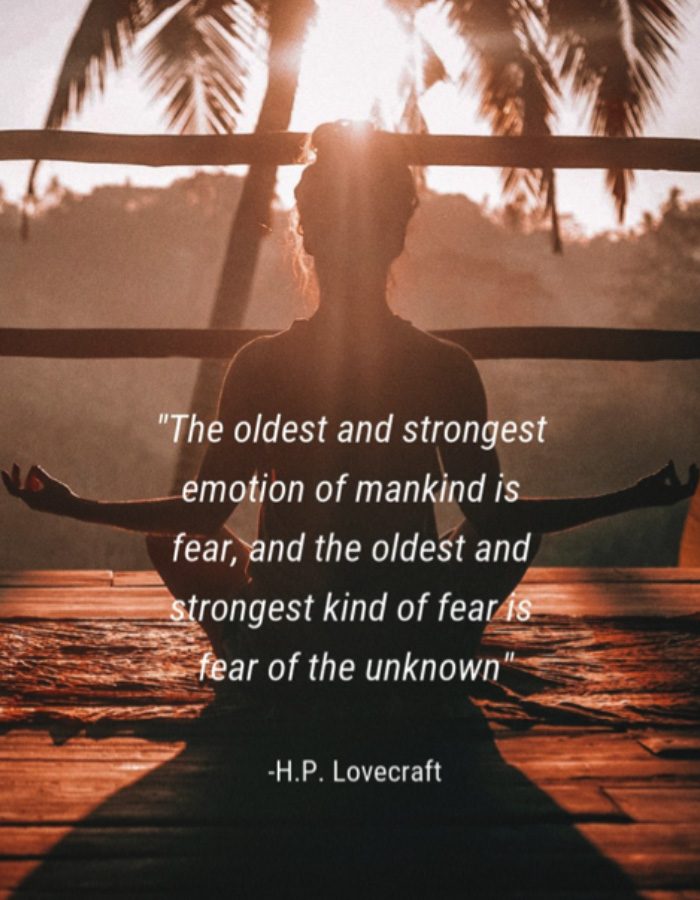What Does Science Say About Meditation for Fear and Anxiety? (Answers Below)
Guided meditation for anxiety is becoming popular. Does it work and what does science have to say about meditation for fear and anxiety?
According to the World Health Organization2, 264 million people around the world experience anxiety. Some experience mild anxiety relevant to specific situations, while some endure it every day. Anxiety is an emotion that exists in all human beings. It has helped us survive and evolve over the millennia.
Our brains have not evolved enough to cope with anxiety in the 21st century. Our modern day-to-day lives do not resemble the wilderness of our ancestors nor the immediate threats they faced every day.
Understanding fear, where it comes from and how you manage it when it becomes unhealthy, are the focus points of this article.
Top 3 Ways Meditation Helps Anxiety and Fear
- Meditation reduces and assists the management of the fight, flight and freeze responses.
- It teaches you to breathe and brings you back to the present.
- Meditation provides an opportunity for stillness – away from worry and over-thinking.
What is Anxiety? What is Happening in the Brain?
Humans experience fear and anxiety from birth. It is an emotion wired into everyone.3 As adults, fear and anxiety present themselves most often when visualising the future. The root of anxiety is a fear of something happening again or a fear of something happening in the future.3 When anxiety becomes chronic, neuropsychology says the fear pathways in the brain have strengthened too much. Just like a muscle, the more it is used, the stronger it gets and the more sensitive it becomes.3
What Does Anxiety Look Like in the Body?
Anyone who has experienced any form of anxiety will usually attest to it being an emotion and an experience they would rather avoid. Symptoms can include:
- Interrupted sleep.4, 5
- Tight muscles.4
- Irritability and feeling on edge.4, 5
- Tight chest and rapid breathing.5
- Sweaty palms.5
- Worry and over-thinking5
- Hot and cold sweats5
Anxiety activates a whole-body response, including activation of the endocrine (hormone) system.6 This is similar to what happens when a person goes into fight, flight or freeze mode.6 The body is essentially going into survival mode.
- Senses become heightened.
- Energy is routed to essential organs.
- Blood pressure increases and adrenaline kicks in.
How Does Guided Meditation for Anxiety and Fear Help?
What does science say?
Decades of study provide ample information and confidence in the efficacy of meditation. Studies show that meditation reduces anxiety symptoms.4, 6-8 Impressive results from an experiment conducted by Hoge et al. provide proof.4 Over eight weeks, participants attended meditation classes and sessions. Stress levels, sleep quality and anxiety were assessed at the beginning and end of the study. The results show the advantages of meditation with experienced improvements to4:
- Responding to and managing high stress.
- The ability to let go of negative thoughts.
- Positive self-talk and positive self-regard.
- Sleep patterns.
A Break-Down of the Top Three Reasons to try Meditation for Fear Management
1. Meditation reduces and assists the management of the fight, flight and freeze responses
Meditation reduces anxiogenic levels in the body.7 By reducing anxiogenics in the body, the HPA axis can also be calmed. The HPA axis is a term used to refer to the hypothalamus, pituitary gland and adrenal system.9 When these areas of the brain are activated, stress and anxiety responses increase.
2. It teaches you to breathe and brings you back to the present
Meditation allows us a moment to breathe deeply and slowly.10 When the mind is racing and over-thinking, meditative breathing can help quell the activation of the fight, flight and freeze response in the body. Slow breathing is a top strategy recommended for managing anxiety.10
3. Meditation provides an opportunity for stillness – away from worry and over-thinking
Grounding ourselves through meditative practice can bring about a sense of stillness10 Meditation types vary around the world. One method is guided meditation. During a guided meditation, meditators listen to a voice that guides them through the meditation. Some guided meditations help to focus on relaxing muscles. Others guide meditators through a journey to awaken and heal their chakras.11 For example, using the fire element in a guided meditation to overcome fear and anxiety.11
Remember that anxiety and fear are natural. If you need help, please don’t hesitate to ask for it. Learn more about how anxiety and fear can be managed and who can help you on the Beyond Blue website.
If you want to learn more about meditation and anxiety, you are welcome to go through the references used in the article below.
References
- Good Reads. H.P. Lovecraft Quotes. 2020
- World Health Organization. Depression and Other Common Mental Disorders: Global Health Estimates. 2017.
- Panksepp, J & Biven, L. The Ancestral Roots of Fear, in The Archaeology of Mind: Neuroevolutionary Origins of Human Emotions. Book. 2012; Norton and Company.
- Hoge, EA, Bui, E, Marques, L, Metcalf, CA, Morris, LK, Robinaugh, DJ, Worthington, JJ, Pollack, MH & Simon, NM. Randomized controlled trial of mindfulness meditation for a generalized anxiety disorder: effects on anxiety and stress reactivity. The Journal Of Clinical Psychiatry. 74. 2013; 786-792.
- Beyond Blue. Signs and Symptoms. 2020.
- Steimer, T. The Biology of Fear – and Anxiety-Related Behaviors. Dialogues in Clinical Neuroscience. 4. 2002; 231-249.
- Chen, KW, Berger, CC, Manheimer, E, Forde, D, Magidson, J, Dachman, L & Lejuez, CW. Meditative Therapies for Reducing Anxiety: a Systematic Review and Meta-analysis of Randomized Controlled Trials. Depression and Anxiety. 29. 2012; 545-562.
- Greene, JD, Morrison, I & Seligman, MEP (eds). Positive Neuroscience. 2016; Oxford University Press.
- Smith, SM. & Vale, WW. The Role of the Hypothalamic-Pituitary-Adrenal Axis in Neuroendocrine Responses to Stress. Dialogues in Clinical Neuroscience. 8. 2006; 383-395.
- Beyond Blue. Anxiety Management Strategies. 2020.
- Meditation in Sydney. Relaxation Meditation for Anxiety and Fear. 2020.








Read 1 comment and reply